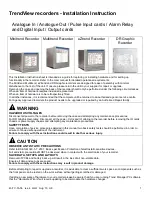
Ecograph T, RSG35
Technical data
Hauser
63
15
Technical data
15.1 Function and system design
Measuring principle
Electronic acquisition, display, recording, analysis, remote transmission and archiving of
analog and digital input signals.
The device is intended for installation in a panel or cabinet. There is also the option of
operating it in a desktop housing or field housing.
Measuring system
Multichannel data recording system with multicolored TFT display (145 mm / 5.7" screen
size), galvanically isolated universal inputs (U, I, TC, RTD, pulse, frequency), digital inputs,
transmitter power supply, limit relay, communication interfaces (USB, Ethernet, optional
RS232/485), optionally available with Modbus protocol, 128 MB internal memory,
external SD card and USB stick. An Essential Version of the reporting software is included
for SQL-supported data analysis at the PC.
The number of inputs available in the basic device can be individually increased using
a maximum of 3 plug-in cards. The device supplies power directly to connected two-
wire transmitters. The device is configured and operated via the navigator (jog/shuttle
dial), via the integrated web server and a PC, or via an external keyboard. Online help
facilitates local operation.
Reliability
Dependability
Depending on the device version, the MTBF is between 52 years and 24 years (calculated
based on SN29500 standard at 40°C)
Serviceability
Battery-backed time and data memory. It is advisable to have the backup battery replaced
by a service technician after 10 years.
Real time clock (RTC)
• Configurable summer/normal time changeover
• Battery buffer. It is advisable to have the backup battery replaced by a service technician
after 10 years.
• Drift: <10 min./year
• Time synchronization possible via SNTP or via digital input.
Standard diagnostic functions as per Namur NE 107
The diagnostic code is made up of the error category as per Namur NE 107 and the
message number.
• Cable open circuit, short-circuit
• Incorrect wiring
• Internal device errors
• Overrange/underrange detection
• Ambient temperature out-of-range detection
Device error/alarm relay
One relay can be used as an alarm relay. If the device detects a system error (e.g. hardware
defect) or a malfunction (e.g. cable open circuit), the selected output/relay switches.
This "alarm relay" switches if "F"-type errors occur (F = failure), i.e. "M"-type errors (M=
Maintenance required) do not switch the alarm relay.
















































